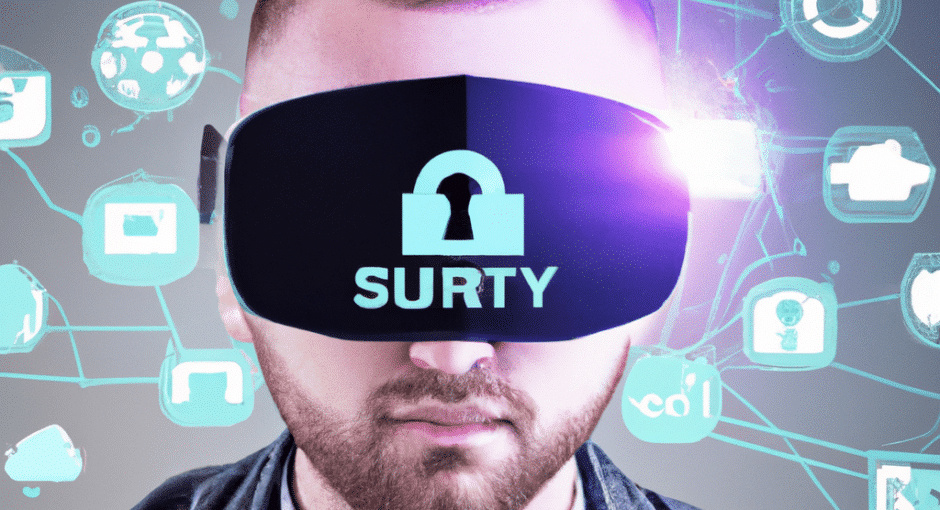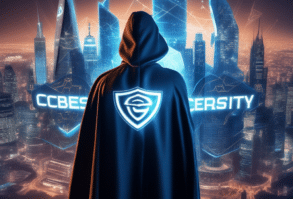Welcome to the world of cybersecurity, where the digital landscape is constantly evolving and threats lurk around every corner. In this technology-driven age, it has become more important than ever to prioritize our online safety and protect our digital lives from malicious actors. Whether you’re a college student, a working professional, or simply someone who spends a significant amount of time connected to the internet, understanding the basics of cybersecurity and implementing daily security practices is crucial.
In this article, we will explore the essential daily tips for end user security, offering practical advice that can help you stay ahead of the threats and safeguard your digital life. From learning the fundamentals of cybersecurity to mastering the art of cyber defense, we will delve into the strategies and education necessary to protect yourself from cybercrimes. So, buckle up and get ready to enhance your knowledge about cybersecurity and end user security.
Section 1, titled "Cybersecurity 101: Essential Daily Tips for End User Security," will lay the foundation by providing a comprehensive overview of the key principles and practices that every individual should follow. We will discuss the significance of strong passwords, the importance of regular software updates, and the dangers of phishing attacks. These tips will equip you with the knowledge to build a solid defense against common cyber threats.
In Section 2, titled "Staying Ahead of the Threats: Practical Cybersecurity Education for Daily Life," we will delve deeper into the realm of cybersecurity education. We will explore the resources available for individuals to enhance their understanding of cybersecurity, including online courses, workshops, and certifications. By investing in your cybersecurity education, you will gain the necessary skills to protect yourself and your digital assets effectively.
Finally, in Section 3, titled "Mastering the Art of Cyber Defense: Proven Strategies to Safeguard Your Digital Life," we will dive into advanced strategies that go beyond the basics. We will discuss the importance of multi-factor authentication, the role of encryption in securing sensitive data, and the benefits of using virtual private networks (VPNs). By implementing these proven strategies, you can create an impenetrable fortress around your digital life.
So, whether you’re a cybersecurity enthusiast or a novice looking to improve your online security, this article is your go-to guide. By the end, you will have the knowledge and tools to navigate the digital world safely and confidently. Let’s embark on this cybersecurity journey together and make our online experiences secure and enjoyable.
- 1. "Cybersecurity 101: Essential Daily Tips for End User Security"
- 2. "Staying Ahead of the Threats: Practical Cybersecurity Education for Daily Life"
- 3. "Mastering the Art of Cyber Defense: Proven Strategies to Safeguard Your Digital Life"
1. "Cybersecurity 101: Essential Daily Tips for End User Security"
Cybersecurity 101: Essential Daily Tips for End User Security
In today’s digital age, where cyber threats are becoming increasingly sophisticated, it is crucial for individuals to prioritize their cybersecurity. As an end user, you play a vital role in safeguarding your personal information and protecting yourself from potential cyber attacks. By following these essential daily tips, you can enhance your end user security and minimize the risk of falling victim to online threats.
1. Keep Your Software Updated: Regularly updating your software, including your operating system, antivirus programs, and web browsers, is essential for maintaining a strong defense against cyber threats. Updates often contain important security patches that fix vulnerabilities in the software, making it harder for hackers to exploit your system.
2. Use Strong and Unique Passwords: Using strong and unique passwords is a fundamental aspect of cybersecurity. Avoid using easily guessable passwords like "123456" or "password." Instead, create complex passwords that combine uppercase and lowercase letters, numbers, and special characters. Additionally, use a unique password for each of your accounts to minimize the impact of a potential data breach.
3. Enable Multi-Factor Authentication (MFA): Multi-factor authentication adds an extra layer of security to your online accounts by requiring additional verification, such as a fingerprint scan or a one-time passcode. Enabling MFA significantly reduces the risk of unauthorized access, even if your password is compromised.
4. Be Wary of Phishing Emails: Phishing emails are one of the most common methods used by cybercriminals to trick individuals into revealing sensitive information or downloading malicious software. Be cautious when opening emails from unknown senders and avoid clicking on suspicious links or attachments. Verify the legitimacy of the email by contacting the sender directly if you have any doubts.
5. Practice Safe Browsing Habits: When browsing the internet, it is crucial to exercise caution. Stick to reputable websites and avoid clicking on unfamiliar or suspicious links. Be wary of pop-up windows and avoid downloading files from untrustworthy sources, as they may contain malware or ransomware.
6. Backup Your Data Regularly: Regularly backing up your important files and data is an essential practice in case of a cyber attack or hardware failure. Use external hard drives or cloud storage services to create backups and ensure that your data is safe and recoverable.
7. Stay Educated: Cybersecurity threats and techniques are constantly evolving. Stay updated with the latest cybersecurity news and trends, as well as best practices for end user security. Attend webinars, workshops, or online courses to enhance your cybersecurity education and stay one step ahead of potential threats.
By following these essential daily tips, you can significantly enhance your end user security and protect yourself from cyber threats. Remember, cybersecurity is a shared responsibility, and taking proactive measures to safeguard your digital presence is crucial in today’s interconnected world. Stay vigilant, stay informed, and stay secure.
2. "Staying Ahead of the Threats: Practical Cybersecurity Education for Daily Life"
Staying Ahead of the Threats: Practical Cybersecurity Education for Daily Life
In today’s digital age, cybersecurity has become an essential aspect of our daily lives. With the increasing number of cyber threats and the evolving tactics used by hackers, it is crucial for individuals to stay informed and educated about best practices to protect their online presence. This article aims to provide practical cybersecurity education that can be easily incorporated into our day-to-day routines.
One of the first steps in ensuring cybersecurity is to understand the common threats that we encounter on a regular basis. Phishing attacks, malware, ransomware, and social engineering are some of the most prevalent risks that users face. By familiarizing oneself with these threats, individuals can develop a proactive mindset and be better prepared to identify and respond to potential attacks.
Regularly updating software and applications is another crucial practice that can greatly enhance end user security. Software updates often include patches that address vulnerabilities discovered by developers or reported by security researchers. By keeping our devices up to date, we can ensure that known vulnerabilities are patched, reducing the risk of exploitation by cybercriminals.
Password hygiene is another fundamental aspect of cybersecurity education. Many individuals still rely on weak and easily guessable passwords, making them vulnerable to brute-force attacks. It is essential to create strong, unique passwords for each online account and consider using a password manager to securely store and generate complex passwords. Additionally, enabling two-factor authentication whenever possible adds an extra layer of security, making it significantly harder for hackers to gain unauthorized access.
In today’s interconnected world, it is crucial to practice safe browsing habits. This includes being cautious while clicking on links in emails or messages, avoiding suspicious websites, and refraining from downloading files from untrusted sources. Educating oneself about common signs of phishing attempts, such as misspelled URLs or unusual email addresses, can go a long way in preventing falling victim to scams.
Another aspect of cybersecurity education is staying informed about the latest trends and emerging threats. Following reputable cybersecurity news sources and blogs can provide valuable insights into new attack techniques, vulnerabilities, and recommended countermeasures. By staying up to date, individuals can proactively implement necessary measures to protect themselves against evolving threats.
Lastly, fostering a culture of cybersecurity within organizations and among groups of friends and family is crucial. Cybersecurity education should not be limited to individual efforts; it should be shared and discussed among peers. By encouraging open conversations about cybersecurity and raising awareness about the risks, we can collectively work towards creating a safer digital environment for everyone.
In conclusion, practical cybersecurity education is vital for individuals to stay ahead of the ever-evolving cyber threats in our daily lives. By understanding common threats, regularly updating software, practicing strong password hygiene, adopting safe browsing habits, staying informed, and fostering a culture of cybersecurity, we can significantly enhance our end user security. With the right knowledge and proactive mindset, we can navigate the digital landscape with confidence and protect ourselves from potential cyberattacks.
3. "Mastering the Art of Cyber Defense: Proven Strategies to Safeguard Your Digital Life"
Mastering the Art of Cyber Defense: Proven Strategies to Safeguard Your Digital Life
In today’s digital age, cybersecurity has become a critical concern for individuals and organizations alike. With cyber threats evolving and becoming more sophisticated, it is essential to stay updated on the best practices for safeguarding your digital life. By mastering the art of cyber defense, you can protect your personal information, financial data, and online activities from falling into the wrong hands.
1. Stay Informed and Educated: The first step in mastering cyber defense is to stay informed about the latest threats and vulnerabilities. Cybersecurity education is crucial for everyone, regardless of their level of technical expertise. Regularly reading reputable sources, attending webinars, and following cybersecurity experts can help you stay ahead of potential threats. By understanding the tactics employed by cybercriminals, you can better protect yourself against their attacks.
2. Use Strong and Unique Passwords: Passwords are often the first line of defense against unauthorized access. However, many people still use weak and easily guessable passwords, making it easier for hackers to breach their accounts. Create strong passwords that are at least eight characters long and include a combination of upper and lowercase letters, numbers, and special characters. Additionally, using a unique password for each online account ensures that if one account is compromised, the others remain secure.
3. Enable Two-Factor Authentication: Two-factor authentication (2FA) adds an extra layer of security to your online accounts. It requires users to provide a second form of verification, such as a fingerprint scan or a unique code sent to their mobile device, in addition to their password. By enabling 2FA, even if a hacker manages to obtain your password, they won’t be able to access your account without the second factor.
4. Keep Your Software Updated: Regularly updating your software, including operating systems, web browsers, and applications, is vital for maintaining a secure digital environment. Software updates often include patches for known vulnerabilities, making it harder for hackers to exploit them. Enable automatic updates whenever possible, as they ensure that you are always running the latest, most secure versions of your software.
5. Be Cautious of Phishing Attempts: Phishing attacks are one of the most common and effective methods used by cybercriminals to trick individuals into revealing sensitive information. Be cautious of unsolicited emails, text messages, or phone calls that request personal or financial information. Always verify the authenticity of the sender before clicking on any links or providing sensitive information. When in doubt, contact the organization directly through their official channels to confirm the legitimacy of the communication.
6. Use Secure Wi-Fi Networks: Public Wi-Fi networks are often unsecured, making it easier for hackers to intercept your internet traffic and gain access to your personal information. Avoid connecting to public Wi-Fi networks when accessing sensitive information, such as online banking or entering login credentials. Instead, use a virtual private network (VPN) to encrypt your internet connection and protect your data from prying eyes.
7. Regularly Back Up Your Data: Data loss can occur due to various reasons, including cyber attacks, hardware failures, or accidental deletion. Regularly backing up your data ensures that even if you fall victim to a cyber attack, you can restore your information and minimize the impact. Consider using cloud storage services or external hard drives to securely store your backups.
By following these proven strategies, you can master the art of cyber defense and safeguard your digital life. Remember, cybersecurity is an ongoing process, and staying vigilant is essential in today’s ever-changing threat landscape. Stay informed, educate yourself, and make cybersecurity a priority to protect yourself and your valuable digital assets.
In conclusion, cybersecurity is an essential aspect of our daily lives, and it is crucial that we stay educated and vigilant to protect ourselves from the ever-evolving threats. By following the daily tips outlined in this article, we can significantly enhance our end user security and reduce the risk of falling victim to cyberattacks. Additionally, investing in cybersecurity education enables us to stay ahead of the threats, understand the latest techniques used by hackers, and develop effective strategies to safeguard our digital lives.
Remember, cybersecurity is not a one-time task but an ongoing process that requires continuous learning and adaptation. By mastering the art of cyber defense, we can create a safer online environment for ourselves and others. So, take the time to implement the tips discussed in this article, explore cybersecurity education opportunities, and stay informed about the latest trends and best practices. Together, we can build a more secure digital future.






